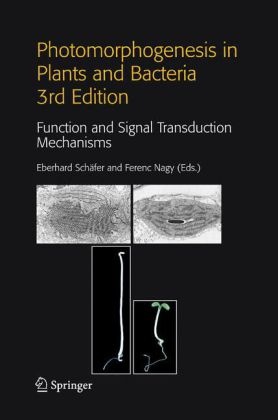Read more
This unique resource reviews progress made by scientists researching into how ambient changes in the wavelength, intensity, direction and duration of light environment affect plant growth and development - explaining how combinations of new research with classical photobiology and physiology made feasible to interpret intriguing light dependent phenomena such as phototropism, determination of flowering time, shadeavoidance etc. at molecular level. Written by over 20 leading experts in the field "Photomorphogenesis in Plants and Bacteria" covers major breakthroughs achieved in the last decade including identification of novel photoreceptors and a variety of molecular mechanisms that mediate photoreceptors controlled signaling induced by the absorption of light photon.Generously referenced with more than 2389 bibliographic citations "Photomorphogenesis in Plants and Bacteria" is an indispensable tool for molecular, cell and applied biologists, geneticists, chronobiologists and upper-level undergraduate and graduate students interested in these disciplines.
List of contents
From the contents
Part 1: General Introduction And Historical Overview Of Photomorphogenesis.- Part 2: The Phytochrome.- Part 3: Blue-Light And UV-Receptors.- Part 4: Signal Transduction In Photomorphogenesis.- Part 5: Selected Topics.- Conclusions. Index.
Summary
Plants as sessile organisms have evolved fascinating capacities to adapt to changes in their natural environment. Arguably, light is by far the most important and variable environmental factor. The quality, quantity, direction and duration of light is monitored by a series of photoreceptors covering spectral information from UVB to near infrared. The response of the plants to light is called photomorphogenesis and it is regulated by the concerted action of photoreceptors. The combined techniques of action spectroscopy and biochemistry allowed one of the important photoreceptors – phytochrome – to be identified in the middle of the last century. An enormous number of physiological studies published in the last century describe the properties of phytochrome and its function and also the physiology of blue and UV-B photoreceptors, unidentified at the time. This knowledge was summarized in the advanced textbook “Photomorphogenesis in Plants” (Kendrick and Kronenberg, eds., 1986, 1994). With the advent of molecular biology, genetics and new molecular, cellular techniques, our knowledge in the field of photomorphogenesis has dramatically increased over the last 15 years.
Additional text
From the reviews:
"The book is of the highest scientific standard and can be recommended to all researchers in plant photobiology as well as to graduate and postgraduate students."
(Biologia Plantarum 36:4, 1994)
"The editors present a book that has long been awaited. … This book on ‘Photomorphogenesis in Plants and Bacteria’ is highly recommended … . It collects contribution from outstanding scientists in this research field. … The overall presentation of the book is acceptable and most of the figures are reproduced with sufficient quality." (Wolfgang Gärtner, Journal of Plant Physiology, Vol. 165 (3), 2008)

